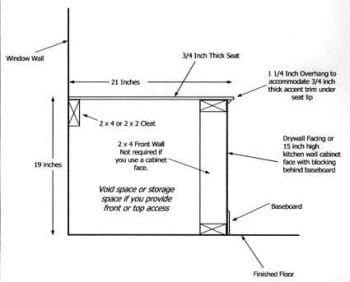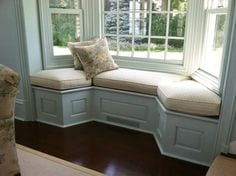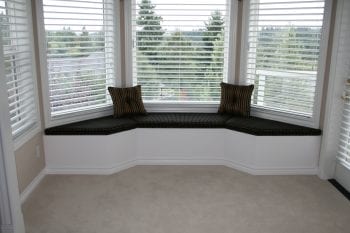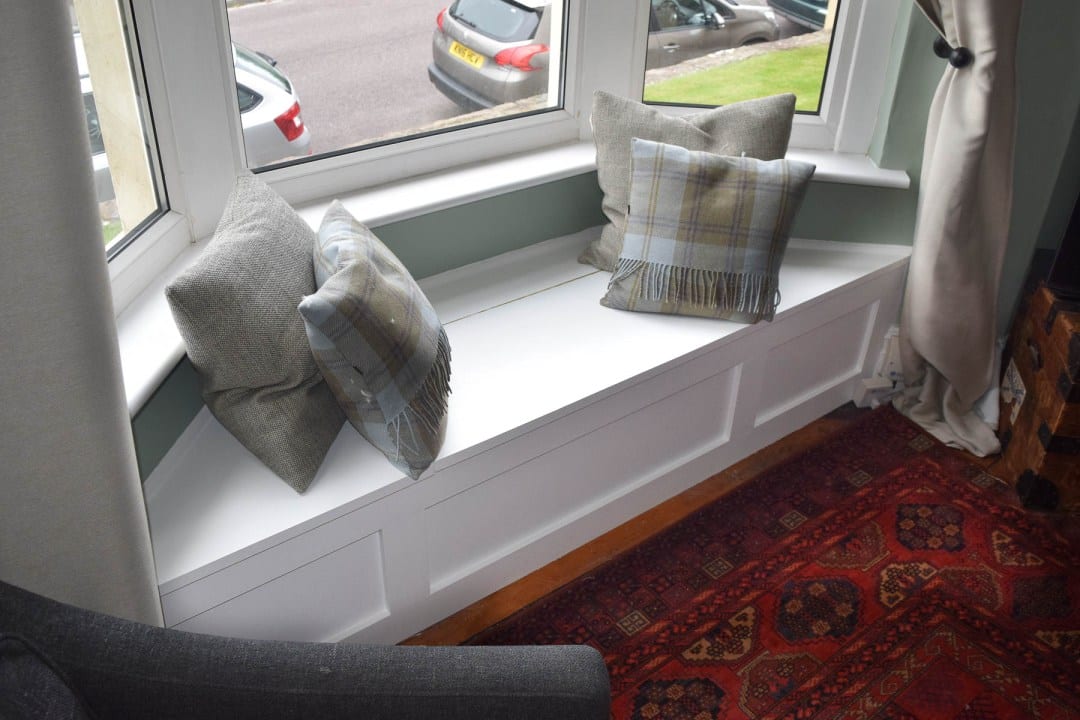

Building your own Victorian window seat is simples when you’ve got the plans made for you. Below you’ll find a basic diagram of a traditional window seat. The only thing you have to figure out yourself are the angles of your wall. Whether you’re working off of a flat wall or a bay window with multiple angles, this project can be customized for a perfect fit.


Let’s Talk About Materials
Start by making necessary measurements. You’ll need to know the angles of your walls, the square footage of your bench space, and just how many 2×4’s to purchase for making the frame of the bench. Standard angles for bay windows are usually 135 degrees. But no two walls are the same and corners are never exactly 90 degrees, so take precise measurements of your walls and angles.
Now you’ll have to decide how deep you would like the seat to be. The diagram in this article shows plans for a seat that is 21 inches deep. You can make this larger or smaller depending on your available space. Keep in mind you’ll need to find cushions that fit the seat.

Determine which type of material you’ll be using for the front of your bench. Some options include sheetrock, wood, plywood, beadboard, reclaimed wood, sheet metal – you name it. Purchase the amount of material you’ll need to cover the face of your seat. This will be the length times the height which equals your square footage. Forget the width – that will give you volume and we aren’t doing anything with that in this tutorial.
You may also want to purchase trim to finish off the bench along the floor and the walls.


Using your measurement of the back wall of which you’ll be mounting the bench, cut a 2×4 to fit. Anchor this 2×4 into the studs using 3.5 inch wood screws.
Next, make the face/front of the bench before mounting it to the wall. You can see in the image below the front of this bench is finished and resting against the wall. You’ll have to use a miter saw to cut the ends of the front piece to match the angle of the wall. Once you’ve made your cuts, push the face of the bench up against the wall and mark the wall where the inside of the bench-front meets the wall. (Make sure your front piece is parallel to the back wall before making your measurments.) 3Then you’ll measure from the back wall where you mounted the 2×4 to the mark you just made to finish framing the wall for your seat. You will not need to miter these cuts. The joint will be covered by the seat and it will add no additional strength to the structure. Make your cuts and anchor the final two frame pieces onto opposing walls. Then mount the front piece of the frame to the 2×4’s anchored to the wall.
Also, you may have to remove baseboards or trim from the wall before installing the frame as they will get in the way.
Now that your frame is mounted to the wall, you’ll measure for the wood you’ll need to create your seat joists. Cut and anchor the wood using wood screws.


There are a number of materials you can use to finish off the front of your seat. In this tutorial, a faceframe was built and painted before mounting to the fixture. You could also use recycled materials, plywood, beadboard, reclaimed wood, pallet boards, and many more things. This tutorial also prefered to build out aspects of the bench and then install them in larger sections. You don’t have to do this, it is optional. You can install the face one piece at a time. Before the faceframe was installed, the builder attached fitted beadboard, then installed the faceframe on top.




Now you’ll start on the top of the window seat. This blogger added a storage space inside of his seat. It does increase the level of skill needed for this project. So if you choose to simplify, you can forgo the storage space. The top of this window seat is made out of four sections of 3/4″ plywood with an attached 1/2″ piece of trim to create the front lip. You’ll see in the image below a diagram of the top seat. Make a diagram for your project that includes your custom measurements so that you know how much material to get and where cuts need to be made.
A five inch strip of plywood running along the back end of the bench was a good width to allow the lid for the storage space to open without running into the wall. Your measurement may need adjustment depending on the materials you’re using to create the door.A piano hinge was used to swing the door open and closed. As you anchor the different parts of the bench seat together, remember to use wood glue and screws when mounting stationary pieces. The door for this seat was measured to fit in between two joists of the seat, with the edges of the door resting on the 2×4’s for support. You could easily change the design to create multiple doors for separated storage space and you could also make the doors on the front of the bench as opposed to the top.
Once your bench seat is assembled and secure, you’ll need to paint or stain it (if you haven’t already done so).


